Comprehensive PESTLE Analysis Report: Canadian Transportation Industry
VerifiedAdded on 2022/10/11
|9
|1588
|11
Report
AI Summary
This report offers a detailed PESTLE analysis of the Canadian Transportation Industry. It begins with an executive summary and table of contents, followed by an introduction emphasizing the significance of transportation in economic development and the use of PESTLE analysis to evaluate market strategies. The discussion section comprehensively examines political factors, including government investments and international treaties; economic factors, such as GDP fluctuations and financial policies; social factors, like safety regulations and immigration impacts; technological factors, including AI in supply chain management and the need for technological adaptation; legal factors, encompassing consumer laws and legislation against modern slavery; and environmental factors, focusing on emission regulations and green supply chain management. The report also includes comparisons with other countries to provide a broader perspective. The conclusion summarizes the findings and underscores the industry's growth and the importance of adapting to current trends. The analysis highlights the importance of considering political, economic, social, technological, legal, and environmental aspects in the Canadian transportation sector.
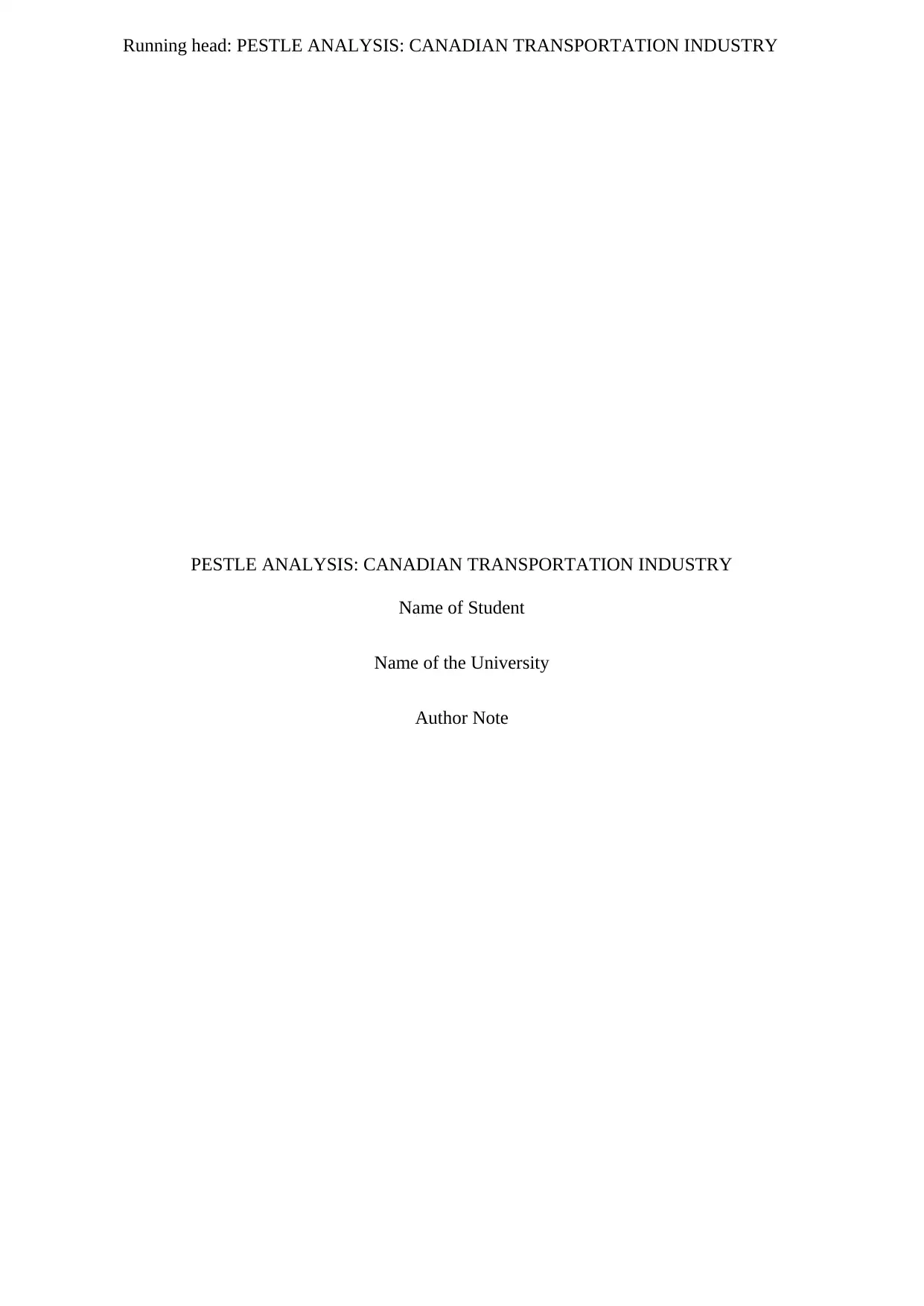
Running head: PESTLE ANALYSIS: CANADIAN TRANSPORTATION INDUSTRY
PESTLE ANALYSIS: CANADIAN TRANSPORTATION INDUSTRY
Name of Student
Name of the University
Author Note
PESTLE ANALYSIS: CANADIAN TRANSPORTATION INDUSTRY
Name of Student
Name of the University
Author Note
Paraphrase This Document
Need a fresh take? Get an instant paraphrase of this document with our AI Paraphraser
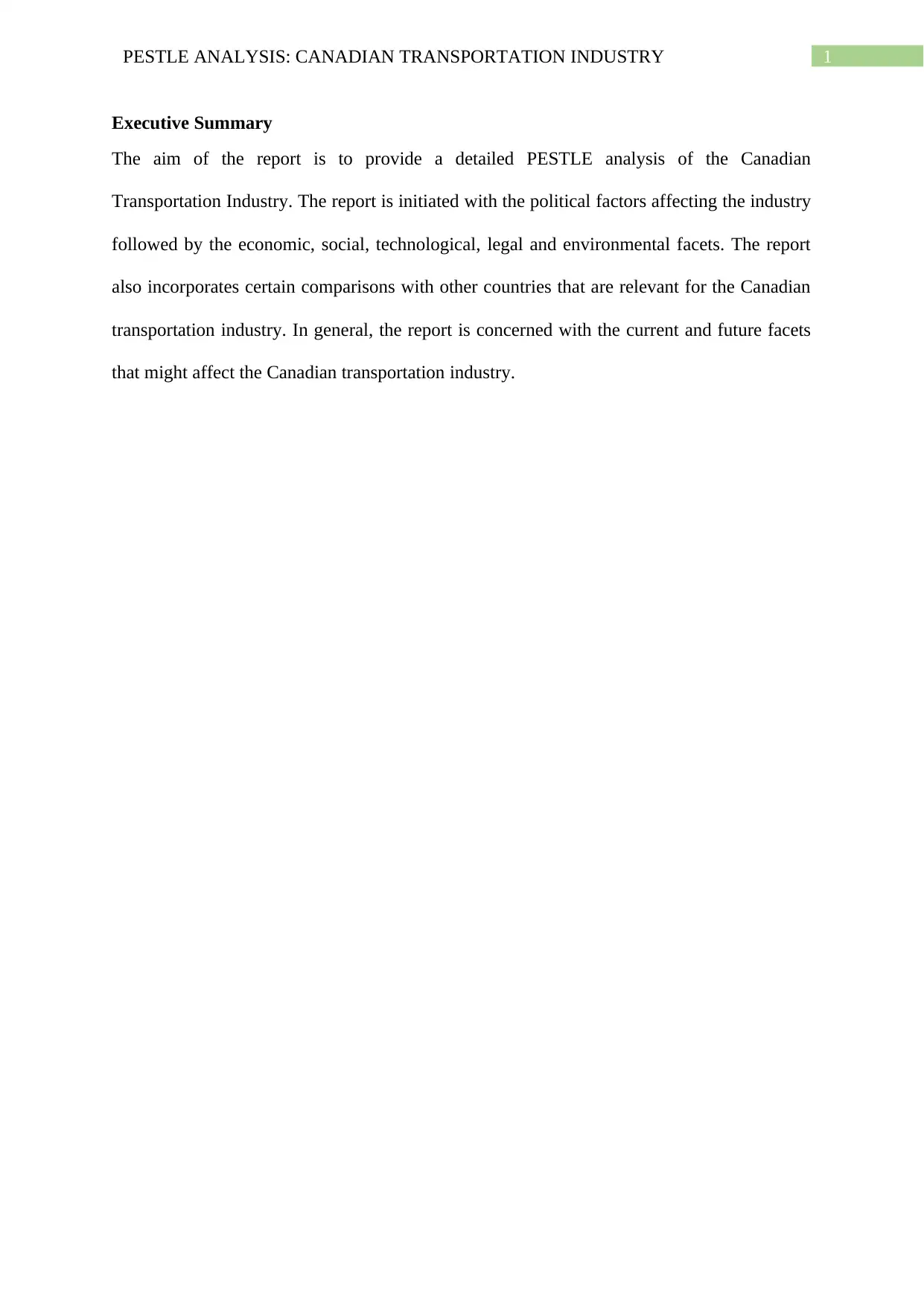
1PESTLE ANALYSIS: CANADIAN TRANSPORTATION INDUSTRY
Executive Summary
The aim of the report is to provide a detailed PESTLE analysis of the Canadian
Transportation Industry. The report is initiated with the political factors affecting the industry
followed by the economic, social, technological, legal and environmental facets. The report
also incorporates certain comparisons with other countries that are relevant for the Canadian
transportation industry. In general, the report is concerned with the current and future facets
that might affect the Canadian transportation industry.
Executive Summary
The aim of the report is to provide a detailed PESTLE analysis of the Canadian
Transportation Industry. The report is initiated with the political factors affecting the industry
followed by the economic, social, technological, legal and environmental facets. The report
also incorporates certain comparisons with other countries that are relevant for the Canadian
transportation industry. In general, the report is concerned with the current and future facets
that might affect the Canadian transportation industry.
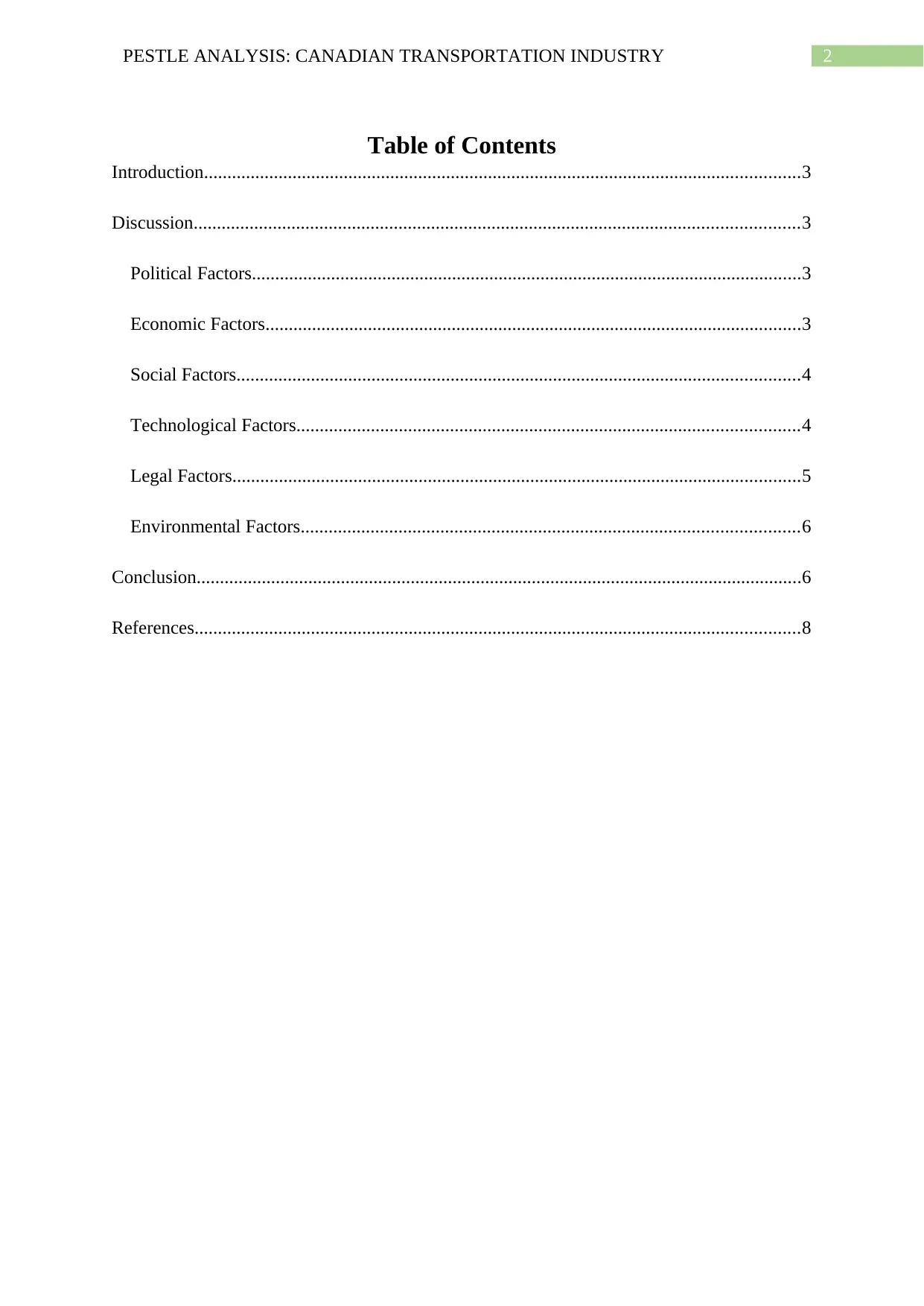
2PESTLE ANALYSIS: CANADIAN TRANSPORTATION INDUSTRY
Table of Contents
Introduction................................................................................................................................3
Discussion..................................................................................................................................3
Political Factors......................................................................................................................3
Economic Factors...................................................................................................................3
Social Factors.........................................................................................................................4
Technological Factors............................................................................................................4
Legal Factors..........................................................................................................................5
Environmental Factors...........................................................................................................6
Conclusion..................................................................................................................................6
References..................................................................................................................................8
Table of Contents
Introduction................................................................................................................................3
Discussion..................................................................................................................................3
Political Factors......................................................................................................................3
Economic Factors...................................................................................................................3
Social Factors.........................................................................................................................4
Technological Factors............................................................................................................4
Legal Factors..........................................................................................................................5
Environmental Factors...........................................................................................................6
Conclusion..................................................................................................................................6
References..................................................................................................................................8
⊘ This is a preview!⊘
Do you want full access?
Subscribe today to unlock all pages.

Trusted by 1+ million students worldwide
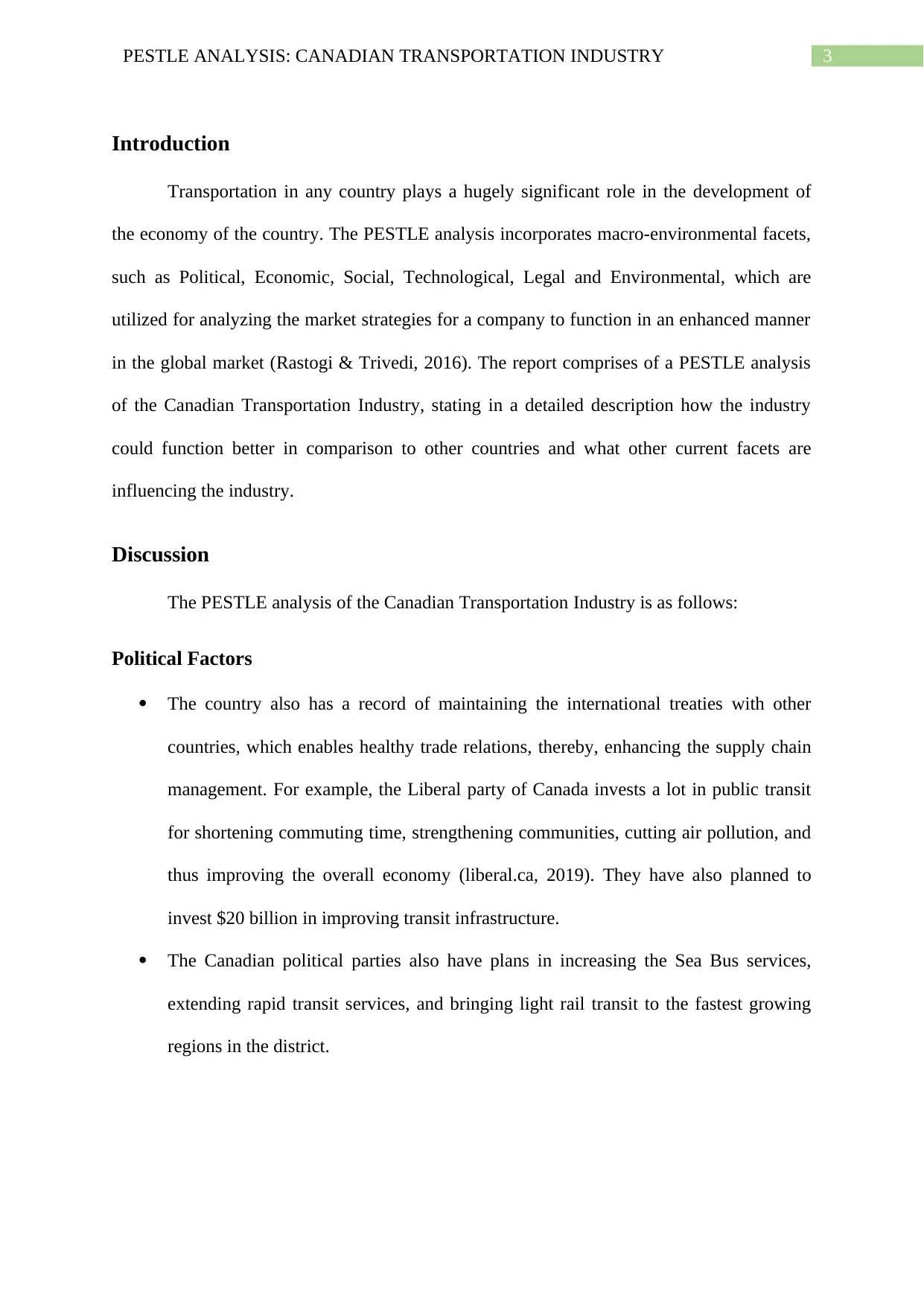
3PESTLE ANALYSIS: CANADIAN TRANSPORTATION INDUSTRY
Introduction
Transportation in any country plays a hugely significant role in the development of
the economy of the country. The PESTLE analysis incorporates macro-environmental facets,
such as Political, Economic, Social, Technological, Legal and Environmental, which are
utilized for analyzing the market strategies for a company to function in an enhanced manner
in the global market (Rastogi & Trivedi, 2016). The report comprises of a PESTLE analysis
of the Canadian Transportation Industry, stating in a detailed description how the industry
could function better in comparison to other countries and what other current facets are
influencing the industry.
Discussion
The PESTLE analysis of the Canadian Transportation Industry is as follows:
Political Factors
The country also has a record of maintaining the international treaties with other
countries, which enables healthy trade relations, thereby, enhancing the supply chain
management. For example, the Liberal party of Canada invests a lot in public transit
for shortening commuting time, strengthening communities, cutting air pollution, and
thus improving the overall economy (liberal.ca, 2019). They have also planned to
invest $20 billion in improving transit infrastructure.
The Canadian political parties also have plans in increasing the Sea Bus services,
extending rapid transit services, and bringing light rail transit to the fastest growing
regions in the district.
Introduction
Transportation in any country plays a hugely significant role in the development of
the economy of the country. The PESTLE analysis incorporates macro-environmental facets,
such as Political, Economic, Social, Technological, Legal and Environmental, which are
utilized for analyzing the market strategies for a company to function in an enhanced manner
in the global market (Rastogi & Trivedi, 2016). The report comprises of a PESTLE analysis
of the Canadian Transportation Industry, stating in a detailed description how the industry
could function better in comparison to other countries and what other current facets are
influencing the industry.
Discussion
The PESTLE analysis of the Canadian Transportation Industry is as follows:
Political Factors
The country also has a record of maintaining the international treaties with other
countries, which enables healthy trade relations, thereby, enhancing the supply chain
management. For example, the Liberal party of Canada invests a lot in public transit
for shortening commuting time, strengthening communities, cutting air pollution, and
thus improving the overall economy (liberal.ca, 2019). They have also planned to
invest $20 billion in improving transit infrastructure.
The Canadian political parties also have plans in increasing the Sea Bus services,
extending rapid transit services, and bringing light rail transit to the fastest growing
regions in the district.
Paraphrase This Document
Need a fresh take? Get an instant paraphrase of this document with our AI Paraphraser
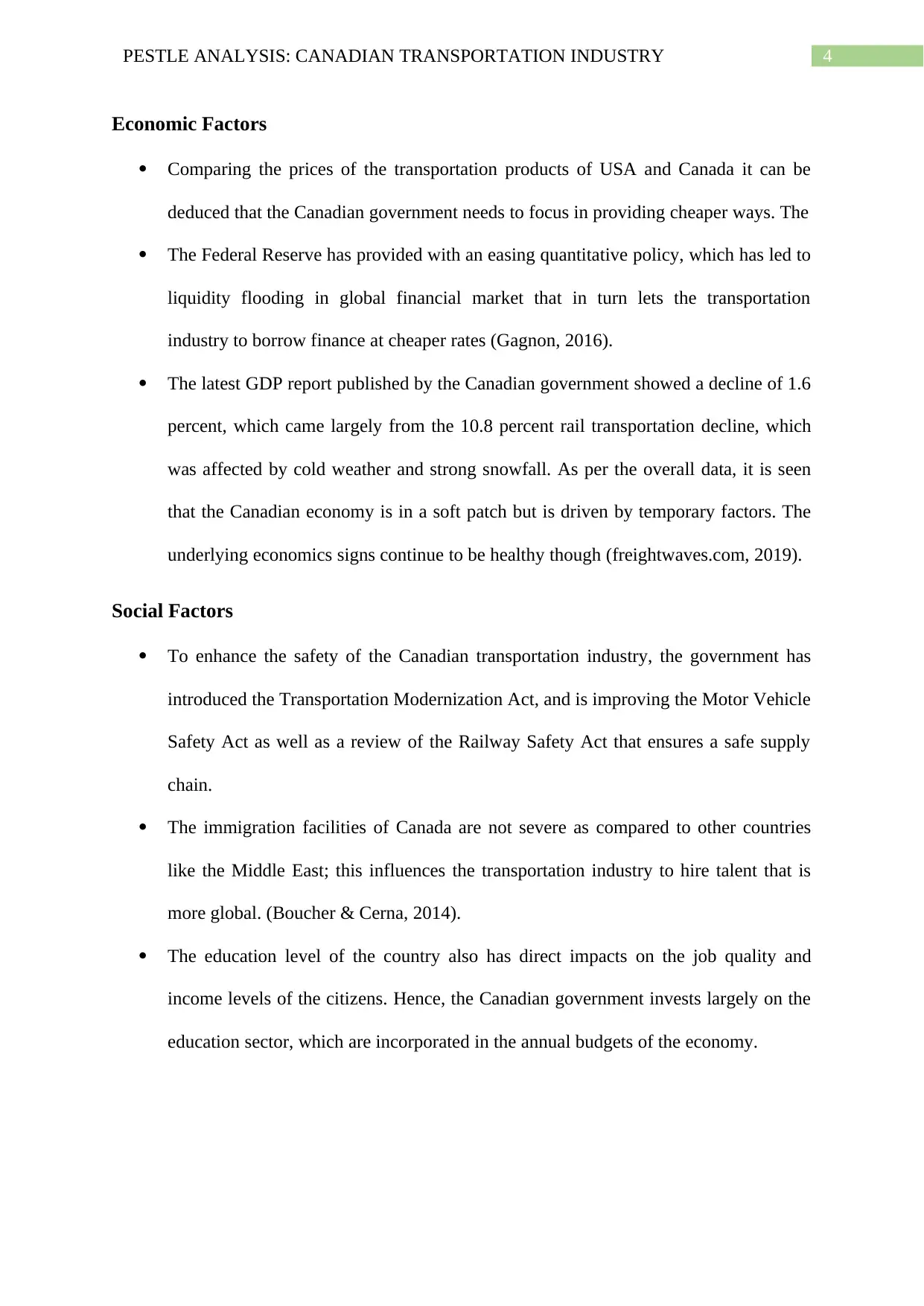
4PESTLE ANALYSIS: CANADIAN TRANSPORTATION INDUSTRY
Economic Factors
Comparing the prices of the transportation products of USA and Canada it can be
deduced that the Canadian government needs to focus in providing cheaper ways. The
The Federal Reserve has provided with an easing quantitative policy, which has led to
liquidity flooding in global financial market that in turn lets the transportation
industry to borrow finance at cheaper rates (Gagnon, 2016).
The latest GDP report published by the Canadian government showed a decline of 1.6
percent, which came largely from the 10.8 percent rail transportation decline, which
was affected by cold weather and strong snowfall. As per the overall data, it is seen
that the Canadian economy is in a soft patch but is driven by temporary factors. The
underlying economics signs continue to be healthy though (freightwaves.com, 2019).
Social Factors
To enhance the safety of the Canadian transportation industry, the government has
introduced the Transportation Modernization Act, and is improving the Motor Vehicle
Safety Act as well as a review of the Railway Safety Act that ensures a safe supply
chain.
The immigration facilities of Canada are not severe as compared to other countries
like the Middle East; this influences the transportation industry to hire talent that is
more global. (Boucher & Cerna, 2014).
The education level of the country also has direct impacts on the job quality and
income levels of the citizens. Hence, the Canadian government invests largely on the
education sector, which are incorporated in the annual budgets of the economy.
Economic Factors
Comparing the prices of the transportation products of USA and Canada it can be
deduced that the Canadian government needs to focus in providing cheaper ways. The
The Federal Reserve has provided with an easing quantitative policy, which has led to
liquidity flooding in global financial market that in turn lets the transportation
industry to borrow finance at cheaper rates (Gagnon, 2016).
The latest GDP report published by the Canadian government showed a decline of 1.6
percent, which came largely from the 10.8 percent rail transportation decline, which
was affected by cold weather and strong snowfall. As per the overall data, it is seen
that the Canadian economy is in a soft patch but is driven by temporary factors. The
underlying economics signs continue to be healthy though (freightwaves.com, 2019).
Social Factors
To enhance the safety of the Canadian transportation industry, the government has
introduced the Transportation Modernization Act, and is improving the Motor Vehicle
Safety Act as well as a review of the Railway Safety Act that ensures a safe supply
chain.
The immigration facilities of Canada are not severe as compared to other countries
like the Middle East; this influences the transportation industry to hire talent that is
more global. (Boucher & Cerna, 2014).
The education level of the country also has direct impacts on the job quality and
income levels of the citizens. Hence, the Canadian government invests largely on the
education sector, which are incorporated in the annual budgets of the economy.
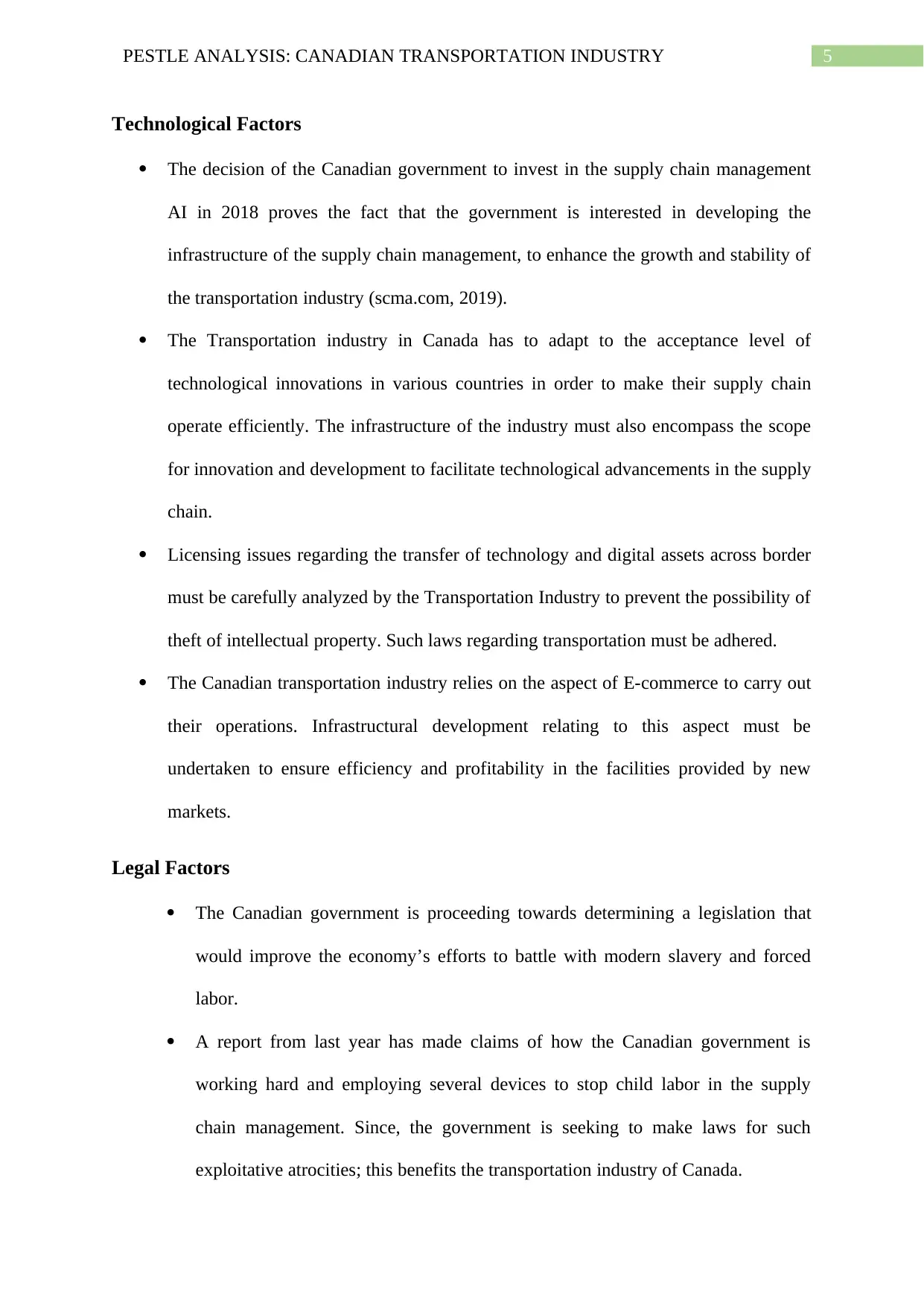
5PESTLE ANALYSIS: CANADIAN TRANSPORTATION INDUSTRY
Technological Factors
The decision of the Canadian government to invest in the supply chain management
AI in 2018 proves the fact that the government is interested in developing the
infrastructure of the supply chain management, to enhance the growth and stability of
the transportation industry (scma.com, 2019).
The Transportation industry in Canada has to adapt to the acceptance level of
technological innovations in various countries in order to make their supply chain
operate efficiently. The infrastructure of the industry must also encompass the scope
for innovation and development to facilitate technological advancements in the supply
chain.
Licensing issues regarding the transfer of technology and digital assets across border
must be carefully analyzed by the Transportation Industry to prevent the possibility of
theft of intellectual property. Such laws regarding transportation must be adhered.
The Canadian transportation industry relies on the aspect of E-commerce to carry out
their operations. Infrastructural development relating to this aspect must be
undertaken to ensure efficiency and profitability in the facilities provided by new
markets.
Legal Factors
The Canadian government is proceeding towards determining a legislation that
would improve the economy’s efforts to battle with modern slavery and forced
labor.
A report from last year has made claims of how the Canadian government is
working hard and employing several devices to stop child labor in the supply
chain management. Since, the government is seeking to make laws for such
exploitative atrocities; this benefits the transportation industry of Canada.
Technological Factors
The decision of the Canadian government to invest in the supply chain management
AI in 2018 proves the fact that the government is interested in developing the
infrastructure of the supply chain management, to enhance the growth and stability of
the transportation industry (scma.com, 2019).
The Transportation industry in Canada has to adapt to the acceptance level of
technological innovations in various countries in order to make their supply chain
operate efficiently. The infrastructure of the industry must also encompass the scope
for innovation and development to facilitate technological advancements in the supply
chain.
Licensing issues regarding the transfer of technology and digital assets across border
must be carefully analyzed by the Transportation Industry to prevent the possibility of
theft of intellectual property. Such laws regarding transportation must be adhered.
The Canadian transportation industry relies on the aspect of E-commerce to carry out
their operations. Infrastructural development relating to this aspect must be
undertaken to ensure efficiency and profitability in the facilities provided by new
markets.
Legal Factors
The Canadian government is proceeding towards determining a legislation that
would improve the economy’s efforts to battle with modern slavery and forced
labor.
A report from last year has made claims of how the Canadian government is
working hard and employing several devices to stop child labor in the supply
chain management. Since, the government is seeking to make laws for such
exploitative atrocities; this benefits the transportation industry of Canada.
⊘ This is a preview!⊘
Do you want full access?
Subscribe today to unlock all pages.

Trusted by 1+ million students worldwide
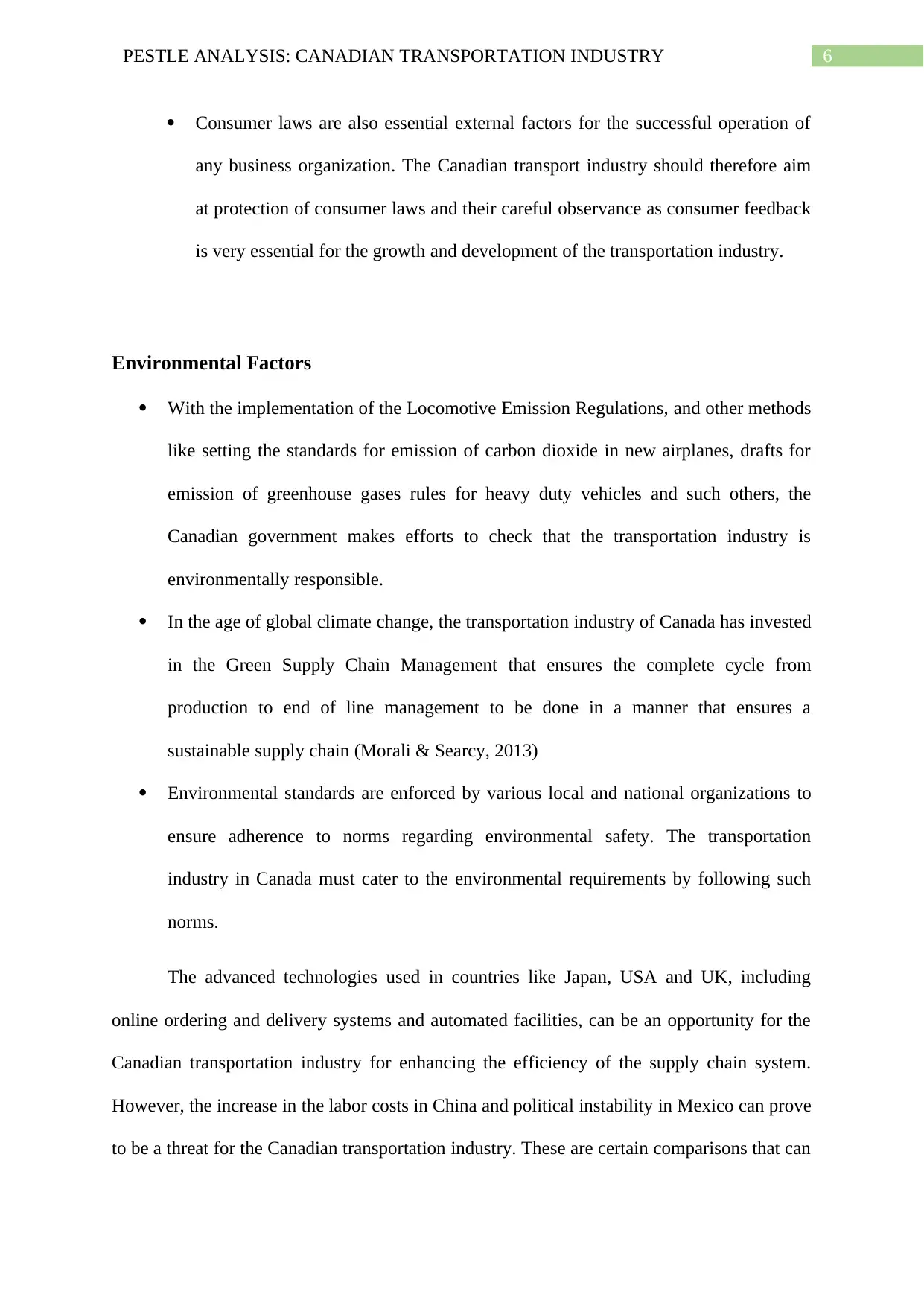
6PESTLE ANALYSIS: CANADIAN TRANSPORTATION INDUSTRY
Consumer laws are also essential external factors for the successful operation of
any business organization. The Canadian transport industry should therefore aim
at protection of consumer laws and their careful observance as consumer feedback
is very essential for the growth and development of the transportation industry.
Environmental Factors
With the implementation of the Locomotive Emission Regulations, and other methods
like setting the standards for emission of carbon dioxide in new airplanes, drafts for
emission of greenhouse gases rules for heavy duty vehicles and such others, the
Canadian government makes efforts to check that the transportation industry is
environmentally responsible.
In the age of global climate change, the transportation industry of Canada has invested
in the Green Supply Chain Management that ensures the complete cycle from
production to end of line management to be done in a manner that ensures a
sustainable supply chain (Morali & Searcy, 2013)
Environmental standards are enforced by various local and national organizations to
ensure adherence to norms regarding environmental safety. The transportation
industry in Canada must cater to the environmental requirements by following such
norms.
The advanced technologies used in countries like Japan, USA and UK, including
online ordering and delivery systems and automated facilities, can be an opportunity for the
Canadian transportation industry for enhancing the efficiency of the supply chain system.
However, the increase in the labor costs in China and political instability in Mexico can prove
to be a threat for the Canadian transportation industry. These are certain comparisons that can
Consumer laws are also essential external factors for the successful operation of
any business organization. The Canadian transport industry should therefore aim
at protection of consumer laws and their careful observance as consumer feedback
is very essential for the growth and development of the transportation industry.
Environmental Factors
With the implementation of the Locomotive Emission Regulations, and other methods
like setting the standards for emission of carbon dioxide in new airplanes, drafts for
emission of greenhouse gases rules for heavy duty vehicles and such others, the
Canadian government makes efforts to check that the transportation industry is
environmentally responsible.
In the age of global climate change, the transportation industry of Canada has invested
in the Green Supply Chain Management that ensures the complete cycle from
production to end of line management to be done in a manner that ensures a
sustainable supply chain (Morali & Searcy, 2013)
Environmental standards are enforced by various local and national organizations to
ensure adherence to norms regarding environmental safety. The transportation
industry in Canada must cater to the environmental requirements by following such
norms.
The advanced technologies used in countries like Japan, USA and UK, including
online ordering and delivery systems and automated facilities, can be an opportunity for the
Canadian transportation industry for enhancing the efficiency of the supply chain system.
However, the increase in the labor costs in China and political instability in Mexico can prove
to be a threat for the Canadian transportation industry. These are certain comparisons that can
Paraphrase This Document
Need a fresh take? Get an instant paraphrase of this document with our AI Paraphraser
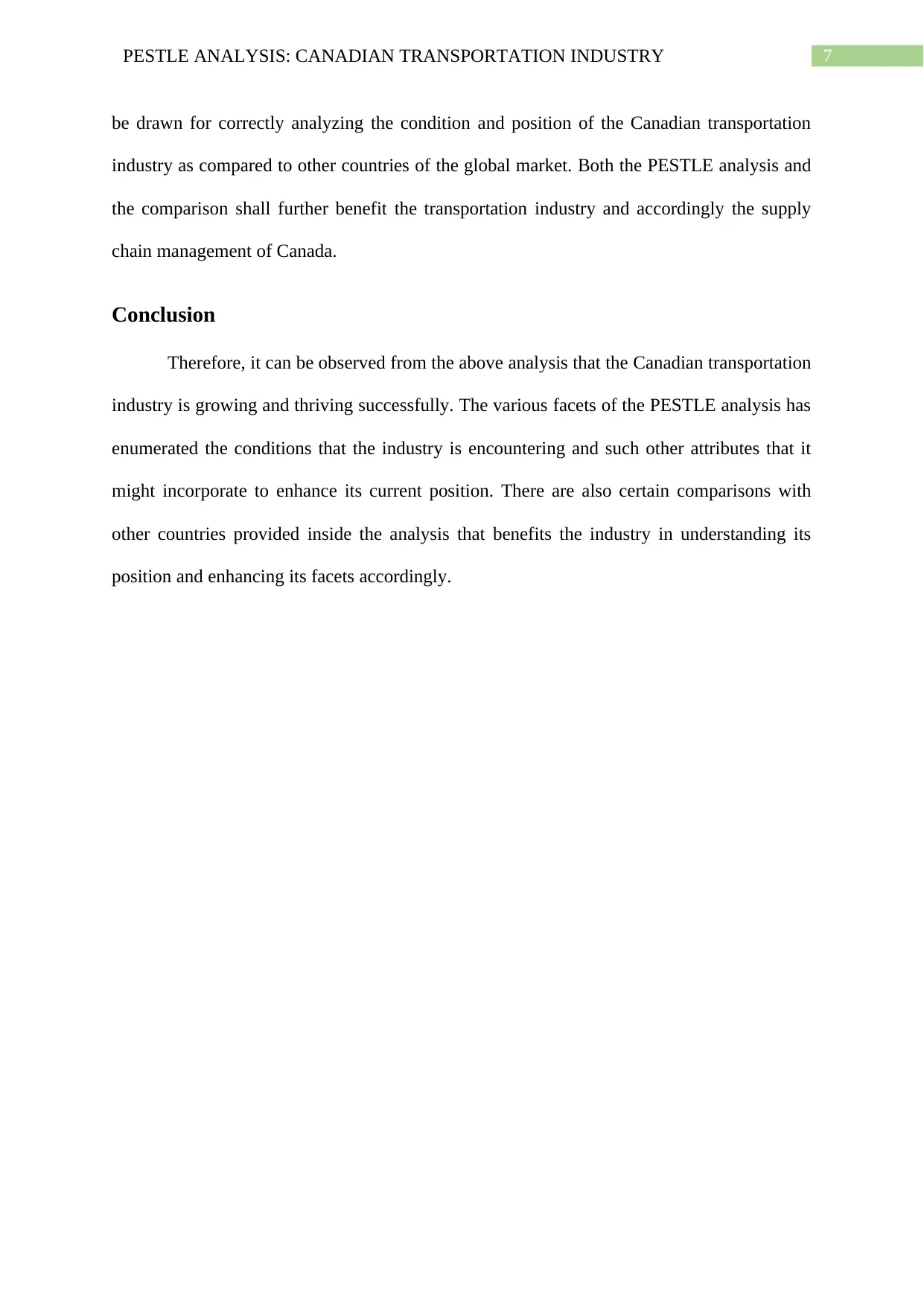
7PESTLE ANALYSIS: CANADIAN TRANSPORTATION INDUSTRY
be drawn for correctly analyzing the condition and position of the Canadian transportation
industry as compared to other countries of the global market. Both the PESTLE analysis and
the comparison shall further benefit the transportation industry and accordingly the supply
chain management of Canada.
Conclusion
Therefore, it can be observed from the above analysis that the Canadian transportation
industry is growing and thriving successfully. The various facets of the PESTLE analysis has
enumerated the conditions that the industry is encountering and such other attributes that it
might incorporate to enhance its current position. There are also certain comparisons with
other countries provided inside the analysis that benefits the industry in understanding its
position and enhancing its facets accordingly.
be drawn for correctly analyzing the condition and position of the Canadian transportation
industry as compared to other countries of the global market. Both the PESTLE analysis and
the comparison shall further benefit the transportation industry and accordingly the supply
chain management of Canada.
Conclusion
Therefore, it can be observed from the above analysis that the Canadian transportation
industry is growing and thriving successfully. The various facets of the PESTLE analysis has
enumerated the conditions that the industry is encountering and such other attributes that it
might incorporate to enhance its current position. There are also certain comparisons with
other countries provided inside the analysis that benefits the industry in understanding its
position and enhancing its facets accordingly.
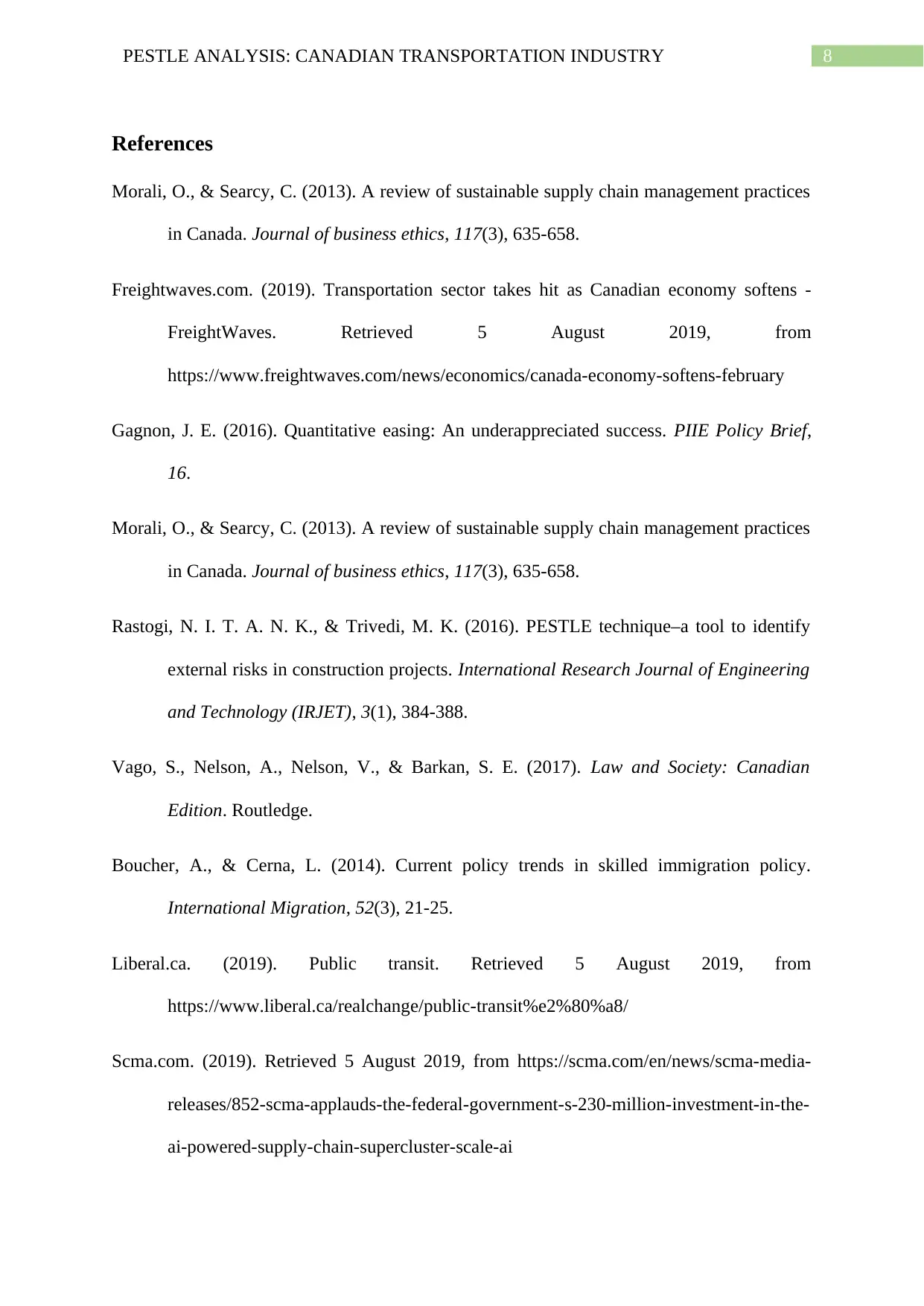
8PESTLE ANALYSIS: CANADIAN TRANSPORTATION INDUSTRY
References
Morali, O., & Searcy, C. (2013). A review of sustainable supply chain management practices
in Canada. Journal of business ethics, 117(3), 635-658.
Freightwaves.com. (2019). Transportation sector takes hit as Canadian economy softens -
FreightWaves. Retrieved 5 August 2019, from
https://www.freightwaves.com/news/economics/canada-economy-softens-february
Gagnon, J. E. (2016). Quantitative easing: An underappreciated success. PIIE Policy Brief,
16.
Morali, O., & Searcy, C. (2013). A review of sustainable supply chain management practices
in Canada. Journal of business ethics, 117(3), 635-658.
Rastogi, N. I. T. A. N. K., & Trivedi, M. K. (2016). PESTLE technique–a tool to identify
external risks in construction projects. International Research Journal of Engineering
and Technology (IRJET), 3(1), 384-388.
Vago, S., Nelson, A., Nelson, V., & Barkan, S. E. (2017). Law and Society: Canadian
Edition. Routledge.
Boucher, A., & Cerna, L. (2014). Current policy trends in skilled immigration policy.
International Migration, 52(3), 21-25.
Liberal.ca. (2019). Public transit. Retrieved 5 August 2019, from
https://www.liberal.ca/realchange/public-transit%e2%80%a8/
Scma.com. (2019). Retrieved 5 August 2019, from https://scma.com/en/news/scma-media-
releases/852-scma-applauds-the-federal-government-s-230-million-investment-in-the-
ai-powered-supply-chain-supercluster-scale-ai
References
Morali, O., & Searcy, C. (2013). A review of sustainable supply chain management practices
in Canada. Journal of business ethics, 117(3), 635-658.
Freightwaves.com. (2019). Transportation sector takes hit as Canadian economy softens -
FreightWaves. Retrieved 5 August 2019, from
https://www.freightwaves.com/news/economics/canada-economy-softens-february
Gagnon, J. E. (2016). Quantitative easing: An underappreciated success. PIIE Policy Brief,
16.
Morali, O., & Searcy, C. (2013). A review of sustainable supply chain management practices
in Canada. Journal of business ethics, 117(3), 635-658.
Rastogi, N. I. T. A. N. K., & Trivedi, M. K. (2016). PESTLE technique–a tool to identify
external risks in construction projects. International Research Journal of Engineering
and Technology (IRJET), 3(1), 384-388.
Vago, S., Nelson, A., Nelson, V., & Barkan, S. E. (2017). Law and Society: Canadian
Edition. Routledge.
Boucher, A., & Cerna, L. (2014). Current policy trends in skilled immigration policy.
International Migration, 52(3), 21-25.
Liberal.ca. (2019). Public transit. Retrieved 5 August 2019, from
https://www.liberal.ca/realchange/public-transit%e2%80%a8/
Scma.com. (2019). Retrieved 5 August 2019, from https://scma.com/en/news/scma-media-
releases/852-scma-applauds-the-federal-government-s-230-million-investment-in-the-
ai-powered-supply-chain-supercluster-scale-ai
⊘ This is a preview!⊘
Do you want full access?
Subscribe today to unlock all pages.

Trusted by 1+ million students worldwide
1 out of 9
Related Documents
Your All-in-One AI-Powered Toolkit for Academic Success.
+13062052269
info@desklib.com
Available 24*7 on WhatsApp / Email
![[object Object]](/_next/static/media/star-bottom.7253800d.svg)
Unlock your academic potential
Copyright © 2020–2025 A2Z Services. All Rights Reserved. Developed and managed by ZUCOL.




